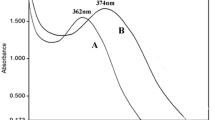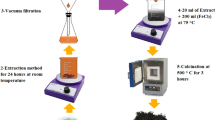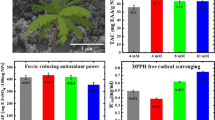Abstract
The elemental tellurium nanoparticles (TeNPs) — sucrose sol was prepared by the reaction of sodium tellurite with ascorbic acid in sucrose aqueous solution. The results indicated that TeNPs were dispersion excellent in the TeNPs — sucrose sol and the morphology of TeNPs was needle-like with about 70 nm in width and 500 nm in length. The antioxidant activity of the TeNPs — sucrose sol in vitro was estimated by pyrogallol autoxidation method, Fenton method and oxygen radical absorbance capacity (ORAC) assay. The results showed that a certain amount of TeNPs — sucrose sol could effectively scavenge superoxide anion free radical and hydroxyl free radical with scavenging rates of 73 % and 57 %, respectively. ORAC assay was used to measure the total antioxidant capacity of TeNPs — sucrose sol. The order of ORAC values was 2.25 μmol·L−1 TeNPs — 0.025 % sucrose sol > 0.025 % sucrose > 2.25 μmol·L−1 Na2TeO3 > 1.63 μmol·L−1 ascorbic acid. The results suggested that the TeNPs — sucrose sol had the excellent antioxidant activity and TeNPs were the dominating contributors to antioxidant capacity of the TeNPs — sucrose sol.
Similar content being viewed by others
References
R B Zheng, W L Cheng, E K Wang, et al. Synthesis of Tellurium Nanorods via Spontaneous Oxidation of NaHTe at Room Temperature[J]. Chemical Physics Letters, 2004, 395(4–6): 302–305
Z P Liu, Z K Hu, Q Xie, et al. Surfactant-assisted Growth of Uniform Nanorods of Crystalline Tellurium[J]. Journal of Materials Chemistry, 2003, 13(1): 159–162
H Zhang, D R Yang, X Y Ma, et al. Transformation Mechanism of Te Particles into Te Nanotubes and Nanowires during Solvothermal Process[J]. Journal of Crystal Growth, 2006,289(2): 568–573
G C Xi, Y Y Peng, W C Yu, et al. Synthesis, Characterization, and Growth Mechanism of Tellurium Nanotubes[J]. NanotubesCrystal Growth & Design, 2005, 5(1): 325–328
J Li, J H Zhang, Y T Qian. Surfactant-assisted Synthesis of Bundlelike Nanostructures with Well-aligned Te Nanorods[J]. Solid State Sciences, 2008, 10(11): 1 549–1 555
J M Song, Y Z Lin, Y J Zhan, et al. Superlong High-Quality Tellurium Nanotubes: Synthesis, Characterization, and Optical Property[J]. Crystal Growth & Design, 2008, 8(6): 1 902–1 908
G Z Shen, D Chen, K B Tang, et al. A Rapid Route for the Synthesis of Submicron Se and Te Rod-like Crystals[J]. Materials Research Bulletin, 2004, 39(13): 2 077–2 082
Z H Lin, Z S Yang, H T Chang. Preparation of Fluorescent Tellurium Nanowires at Room Temperature[J]. Crystal Growth & Design, 2008, 8(1): 351–357
A Taylor. Biochemistry of Tellurium[J]. Biological Trace Element Research, 1996, 55(3): 231–239
E P Painter. The Chemistry and Toxicity of Selenium Compounds with Special Reference to the Selenium Problem[J]. Chemical Reviews, 1941, 28(2): 179–213
T G Chasteen, D E Fuentes, J C Tantaleán, et al. Tellurite: History, Oxidative Stress, and Molecular Mechanisms of Resistance[J]. FEMS Microbiology Reviews, 2009, 33(4): 820–832
M P Rayman. The Importance of Selenium to Human Health[J]. LANCET, 2000, 356(9 225): 233–241
K M Brown, J R Arthur. Selenium, Selenoproteins and Human Health: A Review[J]. Public Health Nutrition, 2001, 4(2B): 593–599
H W Zeng, G F Combs. Selenium as an Anticancer Nutrient: Roles in Cell Proliferation and Tumor Cell Invasion[J]. Jouranl of Nutritional Biochemistry, 2008, 19(1): 1–7
T Ishrat, K Parveen, M M Khan, et al. Selenium Prevents Cognitive Decline and Oxidative Damage in Rat Model of Streptozotocin- induced Experimental Dementia of Alzheimer’s Type[J]. Brain Research, 2009(1 281): 117–127
B Huang, J S Zhang, J W Hou, et al. Free Radical Scavenging Efficiency of Nano -Se in Vitro[J]. Free Radical Biology and Medicine, 2003, 35(7): 805–813
C Y Tone, C G Xue, X M Liu, et al. Research of Antioxidation of Red Nanose by Fluorescence Spectroscopy and Methylthianolyldiphenyltetrazolium Bromide Assay[J]. Chinese Journal of Analytical Chemistry, 2006, 34(12): 1 752–1 754
H L Wang, J S Zhang, H Q Yu. Elemental Selenium at Nano Size Possesses Lower Toxicity without Compromising the Fundamental Effect on Selenoenzymes: Comparison with Selenomethionine in Mice[J]. Free Radic Biology and Medicine, 2007, 42(10): 1 524–1 533
J S Zhang, X F Wang, T W Xu. Elemental Selenium at Nano Size (Nano-Se) as a Potential Chemopreventive Agent with Reduced Risk of Selenium Toxicity: Comparison with Se-Methylselenocysteine in Mice[J]. Toxicological Sciences, 2008, 101(1): 22–31
S N Barnaby, S H Frayne, K R Fath, et al. Growth of Se Nanoparticles on Kinetin Assemblies and Their Biocompatibility Studies[J]. Soft Materials, 2011, 9(4): 313–334
Y H Zhou, J Y Huang, Y Bai, et al. Antiox Idant Activity of Selenium Nanoparticles-sucrose Sol[J]. Journal of Jinan University (Natural Science & Medicine Edition), 2010, 31(1): 71–74
H Y Luo, Y H Zhou, Y Bai, et al. Antioxidant Activity of Selenium Nanoparticle-amino Acid Sols[J]. Food Science and Technology, 2011, 36(4): 202–206
Y Bai, B Y Qin, Y H Zhou, et al. Preparation and Antioxidant Capacity of Element Selenium Nanoparticles Sol-gel Compounds[J]. Journal of Nanoscience and Nanotechnology, 2011, 11(6): 5 012–5 017
C W Nogueira, G Zeni, J B T Rocha. Organoselenium and Organotellurium Compounds: Toxicology and Pharmacology [J]. Chemical Reviews, 2004, 104(12): 6 255–6 285
V P P Schiar, D B dos Santos, D S Lüdtke, et al. Screening of Potentially Toxic Chalcogens in Erythrocytes[J]. Toxicology in Vitro, 2007, 21(1): 139–145
Y Ogra. Toxicometallomics for Research on the Toxicology of Exotic Metalloids Based on Speciation Studies[J]. Analytical Sciences, 2009, 25(10): 1 189–1 195
W J Ding, T Hasegawa, D Peng, et al. Preliminary Investigation on the Cytotoxicity of Tellurite to Cultured HeLa Cells[J]. Journal of Trace Elements Medicine and Biology, 2002, 16(2): 99–102
B Deuticke, P Lutkemeier, B Poser. Tellurite-induced Damage of the Erythrocyte Membrane. Manifestations and Mechanisms[J]. Biochimica Et Biophysica Acta, 1992, 1 109(1): 97–107
S Kumar, L Engman, L Valgimigli, et al. Antioxidant Profile of Ethoxyquin and Some of S, Se, and Te Anologues[J]. Journal of Organic Chemistry, 2007, 72(16): 6 046–6 055
A C G Souza, C Luchese, J S Santos Neto, et al. Antioxidant Effect of a Novel Class of Telluroacetilene Compounds:studies in Vitro and in Vivo[J]. Life Science, 2009, 84(11–12): 351–357
D Sredni-Kenigsbuch, M Shohat, B Shohat, et al. The Novel Tellurium Immunomodulator AS101 Inhibits Interleukin-10 Production and P38 MAPK Expression in Atopic Dermatitis[J]. Journal of Dermatological Science, 2008, 50(3): 232–235
M Friedman, I Bayer, I Letko, et al. Topical Treatment for Human Papillomavirus- associated Genital Warts in Humans with the Novel Tellurium Immunomodulator AS101: Assessment of Its Safety and Efficacy[J]. British Journal of Demotology, 2009, 160(2): 403–408
B L Sailer, N Liles, S Dickerson, et al. Cytometric Determination of Novel Organotellurium Compound Toxicity in a Promyelocytic (HL-60) Cell Line[J]. Archives of Toxicology, 2003, 77(1): 30–36
B Mayers, Y N Xia. Formation of Tellurium Nanotubes through Concentration Depletion at the Surfaces of Seeds[J]. Advanced Materials, 2002, 14(4): 279–282
S K Mahto, T P Vinod, J Kim, et al. Cytotoxic Potentials of Tellurium Nanowires in BALB/3T3 Fibroblast Cells[J]. Bulletin of the Korean Chemical Society, 2011, 32(9): 3 405–3 410
E Alarcón, A M Campos, A M Edwards, et al. Antioxidant Capacity of Herbal Infusions and Tea extracts: A Comparison of ORAC-fluorescein and ORAC-pyrogallol Red Methodologies[J]. Food Chemistry, 2008, 107(3): 1 114–1 119
J L Li, M Zhang, T S Zheng. The in Vitro Antioxidant Activity of Lotus Germ Oil from Supercritical Carbon Dioxide Extraction[J]. Food Chemistry, 2009, 115(3): 939–944
M J Laughton, P J Evans, M A Moroney, et al. Inhibition of Mammalian 5-lipoxygenase and Cyclo-oxygenase by Flavonoids and Phenolic Dietary Additives. Relationship to Antioxidant Activity and to Iron Ion-reducing Ability[J]. Biochemical Pharmacology, 1991, 42(9); 1 673-1 681
Author information
Authors and Affiliations
Corresponding author
Additional information
Funded by the National Natural Science Foundation of China (No. 21075053)
Rights and permissions
About this article
Cite this article
Li, Y., Pan, J., Jiang, K. et al. Preparation of elemental tellurium nanoparticles — sucrose sol and its antioxidant activity in vitro . J. Wuhan Univ. Technol.-Mat. Sci. Edit. 28, 1048–1052 (2013). https://doi.org/10.1007/s11595-013-0817-z
Received:
Accepted:
Published:
Issue Date:
DOI: https://doi.org/10.1007/s11595-013-0817-z




